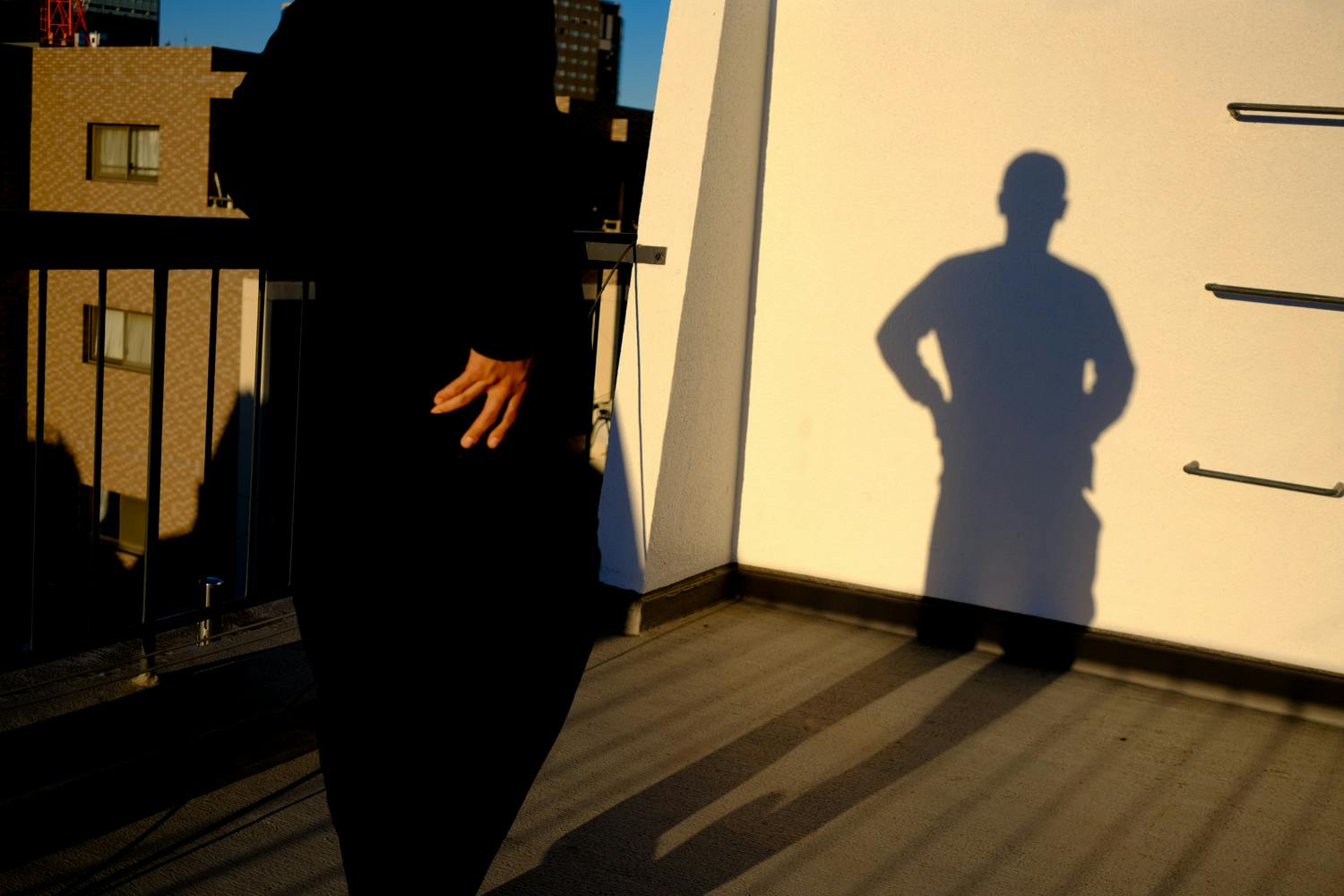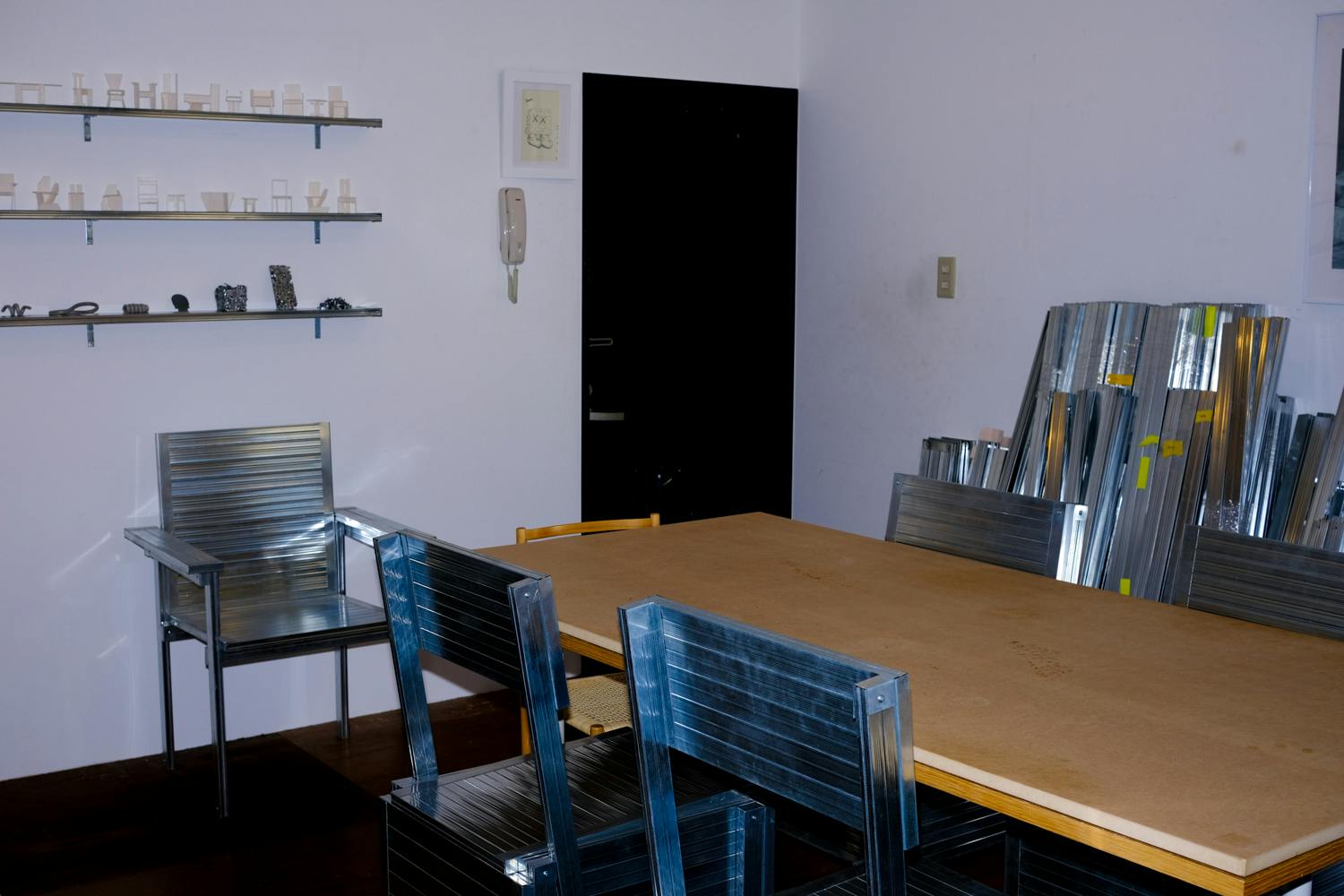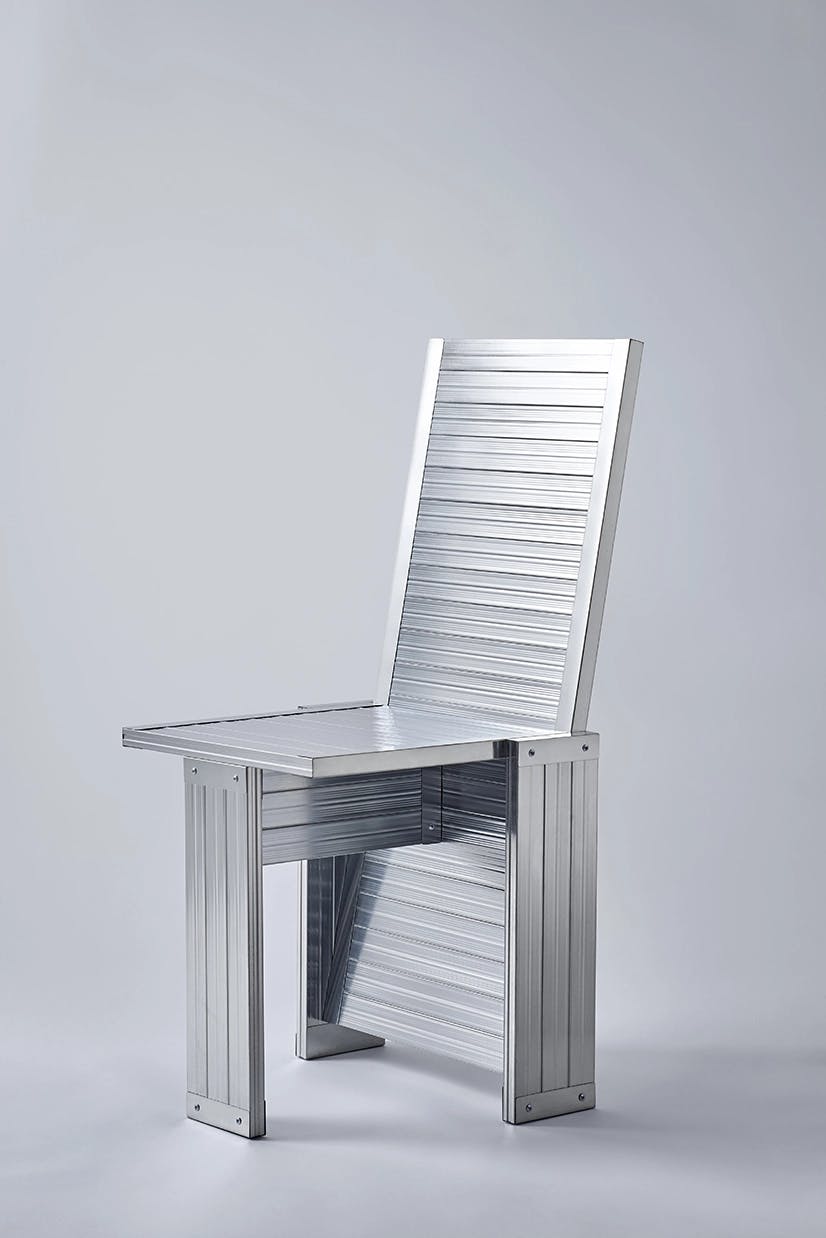
Studio Visit with Daisuke Yamamoto
We visit the Tokyo studio of Architect and Designer, Daisuke Yamamoto
Starting from a holistic methodology inspired by Enzo Mari's DIY studies, Yamamoto is able to see multiple futures in all of the materials he works with. Approaching his architectural practice from the place of questioning: "What will happen to these materials after this architecture's life span?" the FLOW furniture series was born. We visit his Tokyo studio to discuss his philosophy for approaching all creative projects, material experimentation, and Japan's history of experimental retail interiors and take a look at models and deconstructed pieces and how they are extracted from previous architectural projects.


Kristen_ You started your career as an architect, specifically doing a lot of retail shop interiors and temporary pop-up spaces. Can you tell us a little bit about that?
キャリアを建築家としてスタートし、商業店舗のインテリアやポップアップスペースを数多く手がけられてきました。 当時の活動について教えていただけますか?
Daisuke_ I try to think about things by working backwards, thinking about when they will be destroyed and discarded.
By reconsidering the timeline and the current situation, we are confronting issues of construction, demolition, and reuse of materials, as well as thinking about how architecture is possible and working on the development and assembly.
いつかは必ず壊され、廃棄される地点から逆算するプロセスで物事を考えるようにしています。
時間軸を捉え直し、今ある現状を再び見直すことから建設、解体、資材の再利用の問題と向き合い、いかにして建築が可能なのかを考え、資材の開発から組み立て、再活用に取り組んでいます。
How did FLOW [steel furniture collection] come about?
LGSのファニチャーコレクションであるFLOWはどのようにして生まれたのでしょうか?
I’ve always been active in architecture and spatial design before exhibiting FLOW as an independent project at the Milan Design Week.
I am reminded of the state of the city as I create architecture and spaces and of the ‘building and scrapping’. After all, Tokyo has the fastest cycle in the world, where things are constantly created and destroyed. The lifespan of commercial facilities is said to be three to five years. And we will inevitably rebuild them again using new materials, which is part of my field of expertise. The first thing to do is to come to terms with the fact that I'm making something with the assumption that it will be destroyed.
It's really interesting for me to watch, but the scenery I saw a few years ago will, inevitably, no longer be there. Commercial spaces, in particular, tend to disappear within three years or even a year sometimes. In one way, it’s what makes Tokyo so exciting. But I also feel that it's becoming more and more superficial. When I was creating commercial spaces, I was only in charge of the surface layer. However, I was also interested in the work that lies beneath it, and that's how I started my own independent project.
建築や空間デザインをベースに長く活動してきていますが、自主制作としてミラノで展示したプロダクトプロジェクトがFLOWです。
日本で建築や空間を作っていくときに強く感じる、ビルアンドスクラップという現状。やはり東京は世界一早いサイクルで、 ものが作られては壊される。そしてまた新しい資材で作り直していくっていうことが、僕の専門領域の中には必然としてあって。商業施設の寿命は3年から5年って言われているんです。自分がやっぱり取り組むべきは、もうそもそも壊される前提で自分が作っているということに気づき始めたのが発想の始まりですね。東京は移り変わりの早さもあって、すごくエキサイティングな街だと思います。僕も見ていてすごく面白いけども、 自分が何年か前に見た風景が少し経てば無くなっていくっていうのが必然。特に商業空間は、3年とか、早いものだと1年でどんどんなくなっていくこともある。
それがすごい東京をエキサイティングにしている要因でもあるけど、より表層的な方にどんどん向かっているようにも感じます。僕自身は商業空間を作る中で、その表層を扱っていたんだけど、やっぱりその表層の奥にあるものにも興味があって、そこからこの自分が自主プロジェクトを始めたという経緯です。


European architects rarely consider that the things they design will later be destroyed. As an architect, from the beginning of your career, did you start out thinking that you would be designing buildings with the premise of destroying them?
ヨーロッパの建築家はデザインしたものが後に壊されるということをあまり考えないですね。建築家としてキャリアの最初の頃から、 壊すことを前提にデザインされるっていうことは考えて始めていたんですか?
At first, I didn't realise it. It was when I started on my own that I realised that what I had created was being destroyed.
The first thing I worked on was how to reuse things and think about the future when designing. If we think that something we make might be gone in three years’ time, we need to consider this when designing it, by trying to keep the material as pure as possible so that it can be used again. From a sustainability point of view, recycling is the best way to create, by using materials as they are or returning them to their original form. Therefore, we had the idea by returning to the material’s original form, we could make use of it again, and from that point on, we began to focus on the space, or rather, the architectural axis of LGS [Lightweight Gauge Steel].
最初はそれ自身には気づいてなかったんですね。独立してから、自分が作ったものが壊されていくことに気がつきました。
まず僕が最初に取り組んだことは、 いかにリユースしたり、その先のことを考えてデザインすることができないかということです。 作っても3年後に壊れるかもしれないけど、それをあえて逆算的に考えることからデザインを始めていて、できる限り素材を純度の高い状態で次に使えるようにする。サスティナブルの観点においては、リサイクルは素材をそのままの状態で次のものを生み出すこと、元の素材に戻すことが一番良いと考えています。 だから廃材を材料にまた戻し、再び使えるようにすることを作る時点から考えていて、そこで僕たちは空間という建築軸でLGSというものに焦点を当て始めました。
We believe that it’s fine as long as it’s in a highly pure state, that is to say as close as possible to the state in which it will be used. For example, the standard for interior design today in Japan is what is called an infill structure*, in which the foundation is made of LGS with a board pasted on top. A craftsman then breaks it down when dismantling it, but it is impossible to separate the materials since they are glued together and cannot be separated. Therefore the entire waste is loaded onto trucks and taken to industrial waste management companies, something I witnessed at the demolition site.
*Editors note: In Japan, the mainstream construction method is that separates the skeleton (the structural body that supports the building) and the infill.
By separating the highly durable skeleton from the highly flexible infill, which allows you to change the floor plan and interior to suit your lifestyle, it has the advantage of allowing you to easily change the floor plan and equipment and renovate.
So I started trying to figure out what I could do to eliminate that, especially as most of Tokyo is created using it. For example, the LGS is held in place with screws, and I don't need to use any adhesive. So, it's as simple as removing all these screws and putting everything back together.
I started incorporating LGS into the design of stores, most often stores that will be gone in about ten years. I started to think about how I would remove the screws from the floor and take all the LGS apart to collect it, and that's when I started working it into my interior design.
All things, including life and materials, are born and must die. So, the starting point should be to think about things by understanding their provenance and imagining them in reverse.
純度が高いっていうのは、資材がいわゆる使われる最初の状態に限りなく近いままであればいいのではないかというとこです。例えば今の内装は、いわゆるインフィールストラクチャーが標準で、LGSで基礎を作ってその上にボードを貼る。その後にパテで埋めたりとか、表面仕上げをしています。これを解体するときには職人さんが壊していくのですが、接着剤をつけて資材同士がどんどん分離できない状態になっているため、資材の分別ができないですよね。分別ができないから、トラックに乗せて産廃業者に丸ごと預けるっていう状況が生まれています。これが私が解体現場で見た風景だったんです。
そこから、そのような状況を変えていくためにはどうしたらいいかって考え始めました。
インフィールストラクチャーが今の日本の標準施工になっている今、東京の風景はほとんどそれで出来上がっているけど、まずそもそもこれがおかしいんじゃないかっていう疑問を持ったっていうところですね。
例えば、LGSはビスで止めるので接着剤をつけないですよね。したがって、これらのネジをすべて取り外せば、すべて元に戻せるというくらい簡単な作りにできます。
自分が作る店舗デザインにLGSを入れ込んでいますが、店舗は長く見ても10年ぐらいにはなくなります。解体するときにはビスを外して、自分で全部バラバラにして回収するということを最初から考えてデザインに落とし込んでいるんです。
生きることもそうだと思うんですけど、必ず物事は生まれてから死ぬことが決まっている。ならばそこから逆算して物事を考えようという考え方が原点です。


In Paris, there is a system where materials from fashion shows can be donated to a place called ‘La Reserve des Arts’ for young designers to reuse cheaply. Do you have any similar initiatives in Japan?
パリでは‘La Reserve des Arts’と呼ばれるファッションショーなどで使い終わったマテリアルを寄付して、若手デザイナーたちが安くそれらを使うことのできるシステムがあります。日本にはこのような活動はありますか?
No, we don’t. The current standard in Japan is that everything, including things used in exhibitions, ends up in the trash. Since there is no such system in Japan, I was forced to do it myself and develop my own projects.
Of course, if you want to create a longer material cycle, you can use it again in another space, where you might end up using it again for, say, 3 to 5 years. So you need something of higher value. I started working on FLOW because I wanted to impulse a change.
ないですね。一時的な展示などで利用されたものも含め、全て廃棄物になってしまうというのが日本の今のベーシックだと思います。だからこそ私自身が自主的にFLOWのプロジェクトに辿り着きました。
より長いマテリアルサイクルを作りたいと考えた時に、また空間で使うことも当然できるけども、そうすると例えばまた3年とか5年でなくなっていくかもしれない。なので、より寿命を長くすることができるような高い価値のものを作りたいという思いから、プロダクトデザインに着手し始めました。
The current lifespan for LGS is said to be approximately 30 to 50 years, but in reality, it lasts much longer. The bottom line is that the minimum lifespan guaranteed by the manufacturer is 30 years, while the building materials, if made properly, are made to last much longer.
So if LGS is only used for three years, I'm wondering where the other twenty-seven years go! I don't think about it as doing something particularly sustainable. I just think it's normal to think about these things. If something’s dirty, you can just polish it, especially when the material is inside the wall structure and therefore, remains clean. There will be some screw holes in used LGS, but that’s not that big a deal; it doesn’t prevent you from reusing it.
What I was most interested in with this LGS was the lowest layer used to create the inside. LGS is the basic but indispensable framework for building interiors. So, when I looked to see how far into the foundation I could go back, I thought this was the place I should go back to.
LGSの耐用年数は大体30年から50年って言われていて、 でも実際にはもっと長く持つんです。メーカーが最低保証している期限が30年ですが、建材は本当はもっと長く持つようなつくりになっています。
じゃあ短期的な使用になってしまう場合、3年から5年だと想定すると、スポイルされた27年はどうなってしまうんだろうと。こう感じるのはサスティナブルへの意識があるからではなくて、本来当たり前の考え方だと思っています。LGSは壁の構造体として内側に入っているものなので綺麗なまま残っているし、汚れていたら磨けばいい。止めるためのビス穴を開いているけど大きな傷ではありません。
僕がLGSに最も興味を持ったのは、内装の中身を作るための1番最下層にあるマテリアルで、骨組の1番基礎になるものだからです。絶対なくてはならないものがLGSなので、どこまで構造の原点に戻れるかと考えた時にLGSに辿り着きました。


The first thing I thought about was how I could make materials with longer lifespans. At that time, I realised that what I was doing was not about design, nor was it about form. An idea is a concept or, rather an attitude. However, there was no way to make my idea work within the current social system, the only option was to make it DIY. Enzo Mari's work was a great influence when I was a student. He popularised the DIY method and the idea that you can make furniture with just wood and screws. I think he was very strongly appealing to the educational and academic aspects of his work, and his activities overlapped with what I was thinking about the academic aspects of design. So I started thinking about his drawings as I set out making a chair with LGS. So, I have a lot of respect for him and a lot of sympathy for his concept.
はじめにマテリアルの寿命を長くできるものが何かを考えた時に、家具を作ることに決めました。ただ、僕のやってること自体はデザインの話ではないし、形の話ではないと思ったんです。このアイデアはコンセプトというか、姿勢。でも社会のシステムの中では、取り組むことが難しかったので、DIYで作るしかなかったんです。その時に思い出したのが、僕が学生の時にとても影響を受けたEnzo Mariでした。彼はDIYの方法をオープンソースにして、木とビスさえあれば家具が作れることを広めました。教育的なアカデミックな面を強く訴求していると感じたんですが、その活動が僕の今考えていることに重なり始めて。じゃあ椅子を作ろうと思った時に、彼のドローイングをもとにLGSで椅子を作りました。彼にはすごくリスペクトがあるし、彼のコンセプトに強く共感しています。
I started by creating a homage piece with a craftsman at the demolition site. We created a pop-up store with beautiful people for six months during COVID. Stores were closed during that time, but since the fashion product cycle was extremely fast-paced, brands were faced with the problem of not being able to sell their clothes and having to discard them. Then I heard about a vacant property called From First in Aoyama, Tokyo, where Comme des Garçons had its first store. So, we rented the space and created an ephemeral store by simply putting LGS on the floor. I was told it would be gone in six months, so I decided to work backwards and select the parts for the floor that I could use when making furniture. When it came time, we unscrewed the flooring and cut the parts on the spot to turn them into furniture. So, instead of throwing materials and everything into scrap, we gave them a new value. At the time, I wasn’t knowledgeable about making this chair. The idea of coming up with various shapes and the way I thought about the details came to me as inspiration. I'm always experimenting and doing different things, but I made LGS furniture by starting with the Enzo Mari chair. I can now make a variety of things, not just chairs but also tables and shelves.
オマージュ作品を最初に作ったんですが、実際に解体現場で職人さんと2人で制作しました。コロナが流行していた時期の半年間でbeautiful peopleとつくったリミテッドストアの現場です。当時、他のファッションブランドも含め多くの店舗は休業していましたが、ファッションの商品サイクルが非常に速いため、ブランドは服が売れずに廃棄しなければならないという問題に直面していました。その話をブランドから聞いたタイミングで、青山のフロムファーストというコムデギャルソンが1番最初にストアを作った場所がに空き物件が出てきたんです。そこを自分たちが居抜きのまま借りて、床にLGSを引いただけゲリラストアを作りました。半年後には無くなる計画だったので逆算のプロセスを実行することにして、床に引いた部材も家具を作るために部材も選定しながら考えた。
解体現場で僕たちは、床に引いてたもののビスを外してその場で部材をカットして、全て廃材にせずその場で家具にしました。素材を捨てずに新しい価値を与える っていうことを始めたんですね。当時まだ僕も知見がなかったので、この椅子を作ったことによっていろんな形のイマジネーションとインスピレーションが湧いてきた。常に今も実験しながらいろんなことやっていますが、最初にEnzo Mariの椅子を作ることを通じて、僕はLGSの家具が作れるようになった。今は椅子に限らず、テーブルやシェルフなど、いろんなものを作り始めています。


Are there any different ways of thinking about wood between Japan and Europe?
ヨーロッパと日本では木への向き合い方は異なると思いますか?
Japan definitely has more attention to detail when it comes to wood. If you look into the history of wood, you will hear about the Ise Grand Shrine in Japan, that’s rebuilt every 20 years. Although 2,000 years have passed since Ise Jingu was first built, it has never been registered as a World Heritage Site for that very reason.
One of the purposes of rebuilding it every 20 years was to pass on the techniques, and the wood discarded at that time will then be distributed for the restoration of other shrines across Japan. This also serves as an inspiration for me. Therefore, what we need to do is create a sustainable society by reconsidering what we currently have, and thinking that we may be able to do more with what we have.
日本はやはり木に対する細やかさは持っているのではないでしょうか。木材の歴史も調べると、伊勢神宮の昔年編宮というのがあり、20年に一度建て直しを行っています。伊勢神宮ができてから2000年が経ちますが、常に立て替え続けてきているので世界遺産には登録されていないです。
20年に1回建て直しが行われる目的は技術の伝承というのも興味深いポイントですが、もっと面白いのは取り壊された木材は日本全国にある神宮の修復剤として配られるんですね。これも僕の活動の一つのインスピレーションになっています。だから、僕たちがやらなければいけないのは、新しいものを使ってサスティナブルな社会を作るのではなくて、今あることをちゃんと見直すことで、もっとできることがあるんではないかと考えています。
What is your next project?
次はどんなプロジェクトを考えていますか?
I really want this to be a sustainable project, so I will continue working with LGS. However, I think that there will be other approaches that can be considered the more I move along.
The reason why I create objects in the field of contemporary design is that by incorporating these into a product or project, I can convey the idea as well as the background to people. I feel the general concept has potential. For example, this could be an opportunity for people to learn about LGS while hearing about the concept I'm working on. We like to communicate the background of the material through one product.
自分がやっていることの責任を全うしたいので、LGSのワークはずっと続けていきます。ただその中で、まだまだ他のアプローチも考えられるのではと思っていますね。
僕自身がいまコンテンポラリーデザインの分野でオブジェクトを作る理由は、それらを製品やプロジェクトに組み込むことで、その背景やアイデアを人々に伝えることができるからです。
例えば、このLGSが何か知らない人たちに知ってもらう機会になり、自分が取り組んでいるもののコンセプトが伝えられる可能性がある。マテリアルの背景を、1つのプロダクトを通じて発信していきたいと思っています。
You are working on developing new materials, textures and applications from waste steel. How do you approach new material development?
廃鋼というマテリアルに新しい命を吹き込み、テクスチャーや新しい用途の開発に取り組まれていますが、どのようなアプローチをされていますか?
My approach is very clear and is based on the idea of not throwing away what we have. It begins with a dialogue with the material in front of us. We are experimenting with our hands to gain a deep understanding of materials and how they can exist with new possibilities.
Although it is a very primitive method, I feel that it is an extremely important procedure that changes the perspective of how materials are handled.
私のアプローチは非常に明快で、今あるものをいかに捨てないかという考えに基づいています。今目の前にある物質との対話から始まります。
素材への深い理解と、どのようにしたら素材が新たな可能性を持って存在することができるのかを自分達の手を動かしながら実験しています。
非常にプリミティブな方法ですが、素材の扱い方の視点を変える非常に大切な手続きだと感じています。
Do you want to explore other materials in the future?
今後はLGS以外の素材も探っていきますか?
Of course. This world is made of a large number of materials. I feel they all have potential.
もちろんです。この世界は非常に多くのマテリアルによって構成されています。その全ての素材に可能性を感じています。



Looking through vintage architecture books in Jimbocho [neighbourhood with a labyrinth of bookshops], you see that Japan has a history of architects pushing the boundaries and innovation of retail design.
What do you think started that, and were there any architects from the past whose retail interiors inspired you?
神保町で手に入れた日本の建築に関する古い書籍を読んでいると、日本には商業施設のデザインにおいて、革新を推し進めた建築家の歴史があると感じました。 どのようなことがきっかけでそのような歴史が生まれたと思いますか?また、山本さんがインスピレーションを受けた建築家はいますか?
Its history, which begins during Japan's period of high economic growth, is based on the premise of a fiction that is born out of the real society and economy but will eventually disappear and a scrap-and-build cycle where things are created and then destroyed.
I believe that architects sensed the “transience'' of things that will inevitably disappear, and therefore saw the potential in them as a means to experiment and raise questions to society, and pursued them.
Many architects have inspired me, but among them, I have been greatly influenced by Shiro Kuramata, who, while working in commercial spaces, continued to create landscapes that he believed in. I think I also learned a lot from Enzo Mari and Andrea Branzi.
I created this chair as an homage to Enzo Mari,I felt that there was an overlap between my respect for him and my undertakings.
日本の高度成長期から始まるその歴史は、現実の社会や経済から生まれつついずれ消滅していくという虚構性、つくっては必ず壊されるというスクラップ アンド ビルドサイクルが前提にあります。
建築家はその中に必ず消滅することへの『儚さ』を感じ、それ故に社会に問いを与える実験の場としての可能性を見出し、追い求めたことがきっかけなのではないかと思います。
私にインスピレーションを与えてくれた建築家は多くいますが、その中でも商業空間に身を置きながら、自分の信じる風景に向かい製作を続けた倉俣史郎さんの姿には大きな影響を受けていると思います。その他にはEnzo Mari、Andrea Branziから多くの姿勢を学んだと思います。
Enzo Mariのオマージュチェアを製作したのも、彼から非常に多くのインスピレーションを受けていたこともあり、尊敬の念と自分の行っている行動が重なる部分を感じ共感の念を込めて製作しました。
I recently invited you to participate in the exhibition BLUE STEEL, co-curated by myself and John Whelan of GSL Gallery. The exhibition explores the material of shiny silver metals, their history and the design world’s current obsession with them. Do you think a material like steel can become trendy or is it timeless? What do you think draws people to this material?
私とGSLギャラリーのジョン・ウィーランがキュレーターを務める展覧会「BLUE STEEL」に、今回山本さんにご参加いただきました。本展示では、鋼材を主役としてその歴史と、昨今のデザイナーがマテリアルに対してどのようにアプローチしているのかを探っていきます。 鋼材というマテリアルはトレンドであるのか、またはトレンドを超越したもののどちらだと思いますか? また本展示のテーマにおいて、どのような要素が人々を惹きつけると思いますか?
I believe that steel is a material that transcends trends. It has been with humans for thousands of years as an extremely important material that supports human activities and development. In that sense, I feel that it is a timeless material.
What I find crucial in this exhibition is not just the trend, but the recognition that steel, having been part of human history, is an intimate material for us, and as creators, we perceive aesthetics and mystique in it that transcend its functional utility as a tool.
鋼材はトレンドを超越したマテリアルだと思っています。
人間の営みや発展を支える非常に大切なマテリアルとして、数千年の長い時間を人間と共に歩んできました。そのような意味でタイムレスなマテリアルだと感じています。
今回の展示では、トレンドとしてではなく人類史を共に歩んできた鋼材が人間にとって親密な素材であると同時に、私たち製作者がそこに道具としての機能性を超えた美学や神秘性を感じていることが大事なのではないかと思います。























